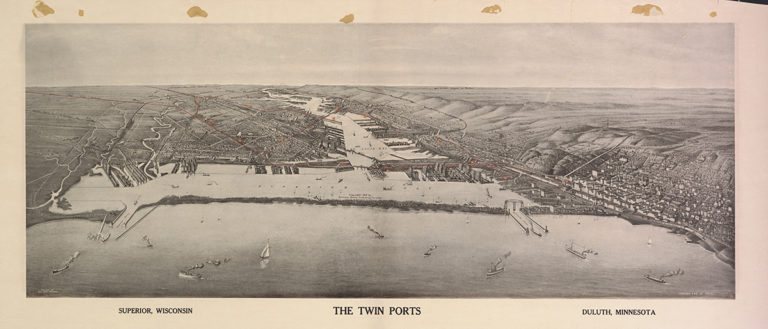Duluth, MN and Superior, WI face each other across the Saint Louis Bay. In the mid-nineteenth century, as grain harvests of the northern plains expanded, logging grew, and as iron and copper mining developed in northern Wisconsin and the Upper Peninsula, shipping on Lake Superior expanded as well. Many eyed the bay as a likely location for a northern Great Lakes port. In the 1850s, Chicago businessmen drew-up maps for a major city. Meanwhile, construction began on the canals at Sault St. Marie, creating a better connection between Lake Superior and the other Great Lakes. With a safe anchorage, access to rail lines throughout the Great West, easy access to the Mississippi River, and a new route to the St. Lawrence River, the Twin Ports became important shipping and boat-building centers in the second half of the nineteenth century.

As the American Steel Barge Company will illustrate, the Twin Ports of Duluth and Superior were sometimes at odds over the shipping industry, but typically ended up operating as a unit for economic reasons. Though both towns grew through logging, iron ore shipment and the harvesting of other resources, their populations ebbed and flowed, leaving Superior smaller than its counterpart.
Alexander McDougall, inventor of the whaleback ship, started building his ships in Duluth, Minnesota. However, his original shipyard on the shore of Lake Superior was low and often flooded. McDougall wanted to expand his operations, and he soon decided he needed more space and higher ground. He found space across the bay in Superior, Wisconsin. Because the two cities were so close to each other, McDougall could draw upon the same pool of skilled labor, and would not have to reroute his supply of iron ore.

From McDougall’s newly chosen site in Superior, the American Steel Barge Company’s operations began in December of 1888. At the time, there were few regulations on ship design, and building with steel was a relatively new concept. Since the invention of the drop keel in the mid-nineteenth century, it had been an established idea that environmental conditions on the Great Lakes demanded new kinds of ship designs and technologies. McDougall’s whaleback ships, with their rounded hulls and steel construction, took that idea even further. The ships built at the American Steel Barge Company offered a cutting-edge idea, not unlike the new steel frame high rise just built in Chicago. The company built and launched the whaleback steamships and consort barges that sailed around the Great Lakes; a few of those ships also traveled the sea. Launched from a small Wisconsin port, for a time, whaleback ships reshaped what shipping looked like across the Great Lakes and beyond.
The first winter in Superior, the American Steel Barge Company employed nearly two thousand men. The working men and their families lived all around the outskirts of the shipyard, close enough to hear the riveting crews and the din of ships being built.
The last whaleback ship was built in 1898, only ten years after the American Steel Barge Company began operations. She was named Alexander McDougall after her creator, who passed away 25 years later at the age of 78. The McDougall, 413 feet in length, was the longest whaleback built. However, by that point the average Great Lakes steamer had grown to roughly 600 feet in length, and the comparatively small whalebacks could not compete. The popularity of whaleback steamers with their consort barge system slowly faded.
As their fortunes waned, the American Steel Barge Company merged into the Superior Shipbuilding Company at the turn of the 20th century. Later called AmShip Superior, the shipyard built vessels during WWI, and after going through many hands, the shipyard is still open today. Though much else has changed, McDougall’s original dry dock still is still in operation, docking vessels for maintenance and repair.
Written by Dara Fillmore, October 2017.






